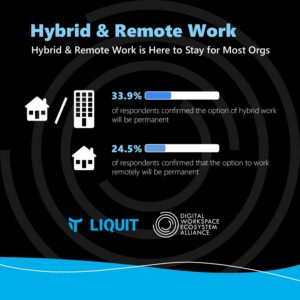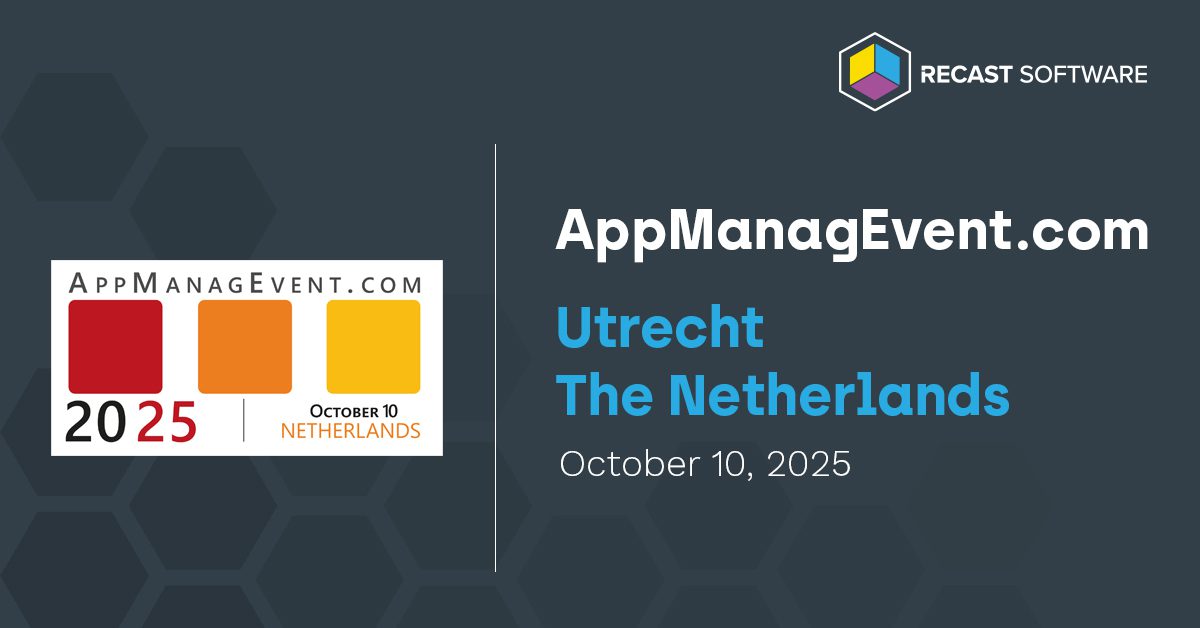Businesses, vendors and MSPs work in a truly hybrid world where hybrid defines the mix of clouds and on prem along with the mix of an onsite and remote workforce. One of the biggest issues they all face are the short-term fixes they implemented for a pandemic that would lead to long-term challenges. Those quick fixes to remote work needs are now breaking down in ways we didn’t anticipate.

Organizations across all sectors are now struggling with delivering long-term work-from-home sustainability while enabling ongoing innovation and progress. This has led to a permanent but still shifting hybrid reality mix of work from home and in-office work. According to a recent Digital Workspace Ecosystem Alliance (DWEA) Survey, 33.9% of workers polled expect their employers to offer a hybrid mix of home and office work while 24.5% expect only working from home.
Hybrid challenges stem from the reality that end user computing is the nexus point of connecting every application, device, system, and platform needed to run a modern organization. The most prevalent challenge is that the modern workforce demands the same user experience (UX) transparency they get from their personal devices. This has created friction between IT and end users because of the critical business functionality that rests with application.
MSPs, integrators and IT teams need effective long-term solutions to manage every application on any device in any location, while also:
- Reducing application lifecycle management redundancies
- Creating new streamlined processes to deliver applications beyond the limits of today’s traditional legacy tools
- Providing effortless agility and adaptability to emerging needs and challenges while ensuring secure access and transparent workflows
We can’t overlook the fact that end user expectations are hard to meet when there are so many IT hurdles to overcome. As IT becomes overworked managing their existing systems and infrastructures, they leave users with devices and processes that are unsatisfying and unproductive, with lots of downtime and confusion.
The only way to make this complexity manageable is to create a way to bring true integration, interoperability, and simplicity to the process. Organizations, MSPs, and the vendors that support them need a way to:
- Streamline and automate management processes
- Fill the gaps in current application management tools and platforms
- Deliver a holistic view of all applications, platforms, environments, and users to create a true end-to-end management environment
Although the cloud and virtualization have always offered great promise for IT and end users, they also present monumental challenges in this new hybrid world.
Application Management Challenges of Cloud and Virtualization
We can define cloud computing as delivering computing power (CPU, RAM, network speeds, storage, OS, and software) as a service over a network (usually the internet). This contrasts with the legacy approach of physically having the computing resources at the onsite location.
The cloud continues its rapid advancements in security, latency, operability, and accessibility. But besides its ability to make applications accessible anywhere at any time, it also brings the potential for greater complexity. This results from constant evolution, as its underlying technologies and tools adapt to meet changing needs for application and service delivery across hybrid and multicloud environments.
Virtualization enables an organization to run virtual versions of computer systems through a layer abstracted from the hardware. It creates virtual instances of IT services that have traditionally been bound to hardware so organizations can run multiple applications and operating systems on a single computer or server.
Virtual Desktop infrastructure (VDI) is an important example of virtualization in modern organizations, in addition to virtual machines (VM). VDI’s creation and management of desktop environments and applications lets employees work and access applications and services anywhere.
Virtualization is now part of the cloud, with many organizations seeking hosted VDI solutions to reduce their hardware carbon footprint and CapEx. Being untethered from a single physical device with OS in the cloud is becoming more cost effective and easier to access for companies employing thousands of devices. The result is a global cloud-based VDI market expected to reach a CAGR of 16.37% between now and 2027, according to Research and Markets.
As VDI in the cloud matures, other cloud evolution approaches like Cloud PC and Desktop as a Service (DaaS) are becoming more popular. These advances create performance, scalability, agility, and lower TCO opportunities. They also create cost, migration, and/or integration challenges for those using legacy VDI systems.
While virtualization is still prevalent, technology and end user needs in a hybrid world are changing faster than ever. Although VDI isn’t going away anytime soon, recent big picture mergers have yet to play out in this space, so the future of what it will look like is uncertain.
Many leaders with an eye on the evolution needs of cloud, hybrid, and virtualization see VDI platform solutions slowly fading away as the most likely scenario because of challenges like:
- High cost and complexity
- Security
- Vendor lock-in
- Scalability limitations
- Over-provisioning
- Poor UX
- Latency
- Management at scale
Their architecture, billing, and user models have left vendors with a lack of flexibility and technology lock-in that makes rebuilding or starting from the ground up impossible.
Some version of VDI will always be around because of legacy applications and infrastructure that are too important to sunset. This creates friction as most MSPs and organizations see the competitive and operational importance of implementing innovative technologies. These organizations are reluctant to abandon the investment and fully migrate away from legacy VDI infrastructures that may last five or even ten years into the future.
This shows how virtualization, and the cloud are just parts of the solution rather than a silver bullet to application management in a hybrid world. They will continue to play a key role in the way organizations deliver and access applications, but they can’t do it alone. They will need to be paired with a solution that makes migration and end-to-end management easy and transparent.
Organizations, MSPs, and vendors face the enormous challenge of how to manage applications and services holistically across different environments while still delivering simple, secure, and efficient access to end users.
True End-to-End Application Management in a Hybrid World
Most organizations are running some applications in the cloud with 91 percent of respondents having moved one or more applications to a new IT environment in the last year, according to a Nutanix survey. A clear majority of respondents to the same survey (83 percent) say a hybrid multicloud approach provides the best means of application and workload placement.
Every organization is looking for ways to make the trend of multi-cloud and Hybrid cloud beneficial through practical management. But they must also ensure that every end user can access every application, from every device, anytime, anywhere, securely, and within compliance. It’s what users want and the business needs.
Managing multiple infrastructures and environments has been happening for decades. But the progression of technology makes it difficult for IT to stay on top of it, which is due to:
- Management and maintenance process overloads that limit IT time and resources for innovation
- The difficulty in managing and delivering applications in the way the business and end users need them
This has broader implications for the organization when the enormous IT time investment in application and platform provisioning, management, and access leads to:
- Excessive cost
- Limited IT personnel and expertise
- Endless and tedious process provisioning, updating, maintenance and patch management
- Redundancy of end-to-end application delivery and management.
Even the cloud expertise of an organization’s SME or their managed service providers guiding cloud management and deployments cannot easily harness the cloud’s inherent versatility in this complex hybrid world. The ideal strategy is to reduce the number of sessions, browsers, and windows required to access applications in multiple environments. This agility and simplicity enable organizations to make the most of their existing legacy platform and architectures and while giving them the power to:
- Limit and lower costs and lock-in
- Make the most of current legacy VDI, DaaS and Cloud PC platforms while lowering costs and management complexity
- Undertake cost effective and quick migration and transition to a more agile and future-proof application management approach
- Make application provisioning, management, security and updates simple and fast for IT teams
- Deliver the secure and transparent anywhere, anytime, any device, and any platform access that end users demand
By aggregating applications to a single workspace, organizations can reduce vulnerabilities and create a more efficient and functional end user experience.
Liquit helps organizations manage applications in multiple disparate environments and aggregates them into a single workspace of choice. Our solution isolates the end user workspace from whatever happens on the back end to eliminate application disruption completely. Liquit also provides the capability to help ease migrations, as well as integrates with existing tools and technologies to ease the burden of ongoing end-to-end application management.
With Liquit, other than the cloud service, connectivity, and initial setup of our platform, there isn’t much to prepare for since we make it so easy to migrate from on-premises to the cloud. The future of your organization’s ability to compete, innovate, and produce is determined by the foundation of agile applications and the cloud. That’s why Liquit makes those applications flow like water from a tap to easily harness those abilities.
The future of every organization’s ability to compete, innovate, and produce is determined by the strength, agility, and transparency of application access across any platform and environment. Organizations and vendors looking for a unifying approach to anywhere, any device, anytime secure and contextual application access to how end users demand to work will benefit in any unknown future scenario.
To learn more about how Liquit can solve the emerging end-to-end application management challenges in your hybrid world, reach out to us here.


